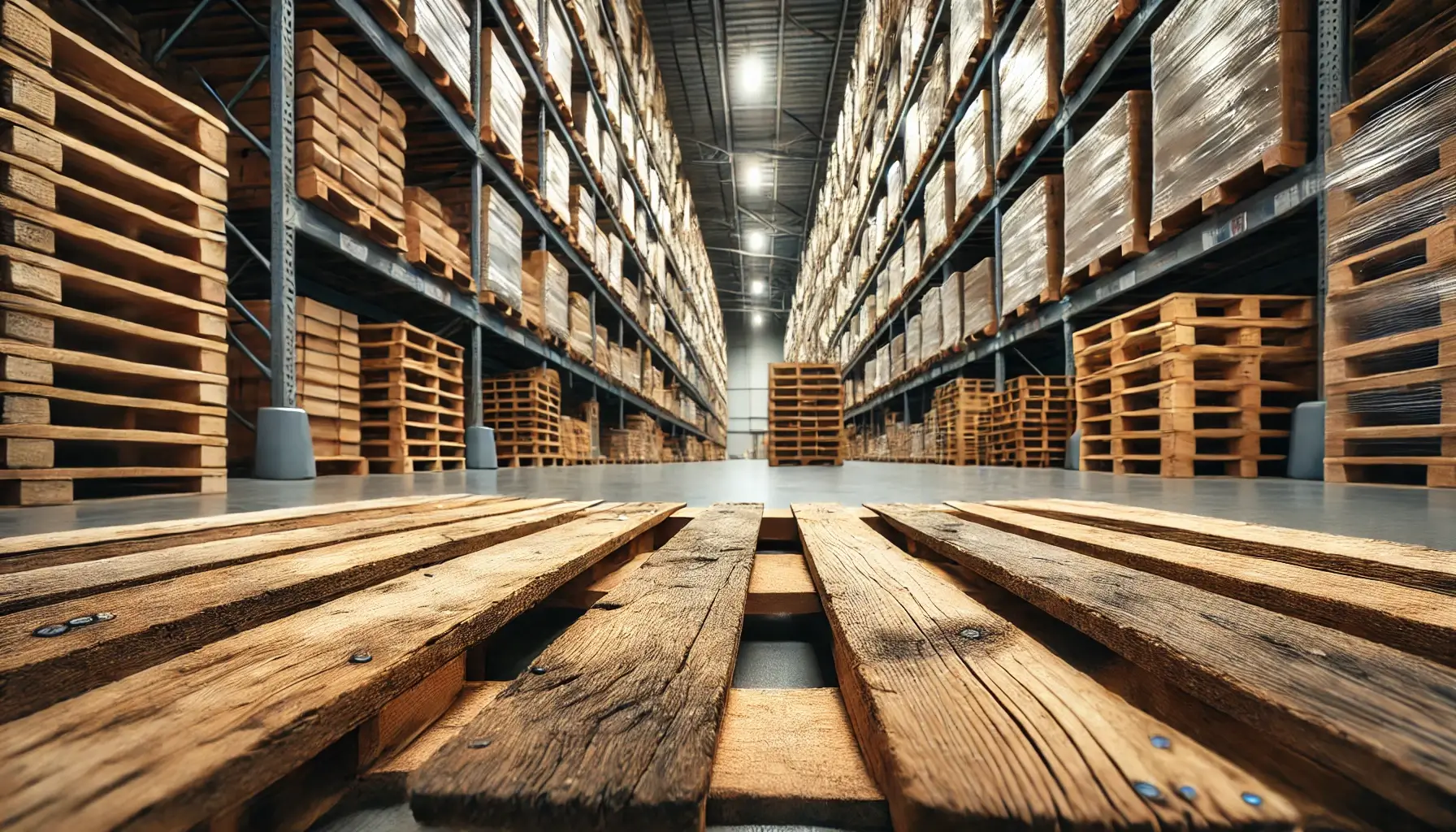This analysis highlights key opportunities to improve the pallet guide. We can do this by using new technology, fresh business models, and current industry trends. These changes are making the simple pallet a key part of today’s supply chain intelligence.
Smart Pallets: The IoT Revolution in Logistics
The traditional pallet is changing a lot thanks to Internet of Things (IoT) technology. Smart pallets are a big step forward in supply chain logistics. They blend traditional load-bearing features with advanced monitoring tools.
What Makes a Pallet “Smart”?
Smart pallets use IoT devices. These devices collect and send important info about the pallet and its cargo in real-time. These pallets have sensors. They track location, temperature, humidity, pressure, acceleration, and other conditions. The technology transforms ordinary pallets into intelligent tools that make operations more efficient and responsive through data collection and analysis.
This innovation offers real-time visibility across the whole supply chain. The smart pallet market is currently worth $20.29 billion. Industry forecasts predict it will grow at a rate of 4.1% each year until 2030. This shows that many businesses will adopt smart pallets in the near future.
Smart Pallet Technology Components
Smart pallets typically feature several key technological components:
- RFID Tags and Sensors: RFID technology helps in automatic identification and tracking. RFID tags are different from barcodes. They do not need line-of-sight scanning, so they are more flexible. Also, they can handle tough conditions.
- GPS Tracking: GPS lets you track pallets in real time. This helps cut down on loss and theft in the supply chain.
- Environmental Sensors: They track temperature and humidity. This matters for items needing careful handling, like pharmaceuticals and perishable goods.
- Data Transmission Systems: These solutions let you send collected data to central systems. This helps with analysis and decision-making.
Svenska Retursystem (SRS), a Swedish company, shows how to use smart pallets effectively. SRS has over one million plastic pallets in use. They chose RFID technology. Barcode solutions couldn’t withstand harsh cleaning chemicals. This often damaged the pallets. Engineers placed RFID tags inside the two-piece pallets. This keeps the tags safe and helps track the pallet reliably.
Benefits of IoT-Enabled Pallets
Smart pallets offer numerous advantages that traditional pallets cannot provide:
Real-Time Visibility and Tracking
Smart pallets provide unprecedented visibility into supply chain operations. Businesses can track their products’ locations in real-time. This cuts down the time spent looking for inventory and helps reduce losses. In warehouses, RFID and GPS sensors help quickly find products. This makes operations much more efficient.
Environmental Monitoring and Product Safety
For sensitive goods, environmental monitoring capabilities are invaluable. Sensors can find issues that may harm product quality. They alert managers about problems like temperature changes or high humidity. This is especially important for pharmaceuticals, food products, and other perishables. Keeping the right environmental conditions is key.
Enhanced Efficiency and Cost Savings
Smart pallets boost efficiency by automating logistics tasks. Smart pallets collect data to improve route planning. They also cut idle times and forecast maintenance needs. Monitoring pallets and goods closely saves money. It reduces losses from theft, damage, or spoilage.
Supply Chain Intelligence
Smart pallets can create useful information that leads to real changes. CHEP says, “The real power of connected assets, like IoT-enabled pallets, isn’t in the devices. It’s in the insights they unlock and the actions they inform.” A single sensor may tell you where one asset is. Linked pallets can find patterns, show bottlenecks, and predict problems. They also help make better decisions on a bigger scale.
Challenges and Considerations
Despite their benefits, implementing smart pallets presents several challenges:
- Metal Interference: In storage systems with steel racks, metal can disrupt sensor data. This is especially true for WiFi-based systems.
- Implementation Barriers: The pallet industry is often fragmented and commoditized. This makes it hard to deploy smart technology on a large scale.
- Integration Needs: Pallet makers, pallet poolers, and tech suppliers must collaborate to succeed.
Pallet Pooling: The Circular Economy in Action
Another key innovation for a complete pallet guide is the pallet pooling system. This is a circular business model that has gained popularity worldwide.
The Pooling Concept
Pallet pooling is a “share and reuse” model based on the principles of the circular economy. Companies rent pallets from a provider. This way, they don’t have to buy or manage them. The provider owns the pallets and takes care of them during their entire lifecycle.
CHEP (Commonwealth Handling Equipment Pool) is a top pallet pooling service. They explain their system like this: “With CHEP, you rent pallets, IBCs, and containers from us.” You can’t buy our pallets or containers. Sharing and reusing makes them more sustainable.
How Pooling Works
The pooling system operates as a closed-loop cycle:
- Order and Delivery: Customers can order pallets using a portal or another system.
- Customers use the pallets to transport their products to retailers or distribution centers.
- Collection: Customers can start right away after delivery. They don’t have to wait for retailers to unload the pallets. The service provider collects the pallets since they belong to the pooling service.
- Inspection and Repair: The pooling company takes pallets to service centers. They check, clean, and repair them as needed.
- Redeployment: Refurbished pallets are sent back into circulation to begin the cycle again.
PECO Pallet entered the Canadian market in 2013. It keeps millions of pallets moving in a closed loop through its depot network. Customers rent these pallets to ship goods to retailers and distributors. After delivery, the pallets are collected, inspected, and reused.
Benefits of Pallet Pooling
Pallet pooling offers several distinct advantages over traditional pallet ownership models:
Reduced Capital Investment
Companies remove the need to buy and store their own pallets. This saves money for main business activities. CHEP says that pooling also removes many worries. Manage storage, handle paperwork, and pay for inspections, repairs, and returns.
Quality Assurance
Pooling providers ensure pallet quality. This way, businesses always have pallets that meet consistent standards. Owned pallets break down over time. They also need a lot of in-house management.
Flexibility for Fluctuating Demand
Companies can change their pallet use based on seasonal shifts or new business needs. This way, they avoid keeping extra inventory during slower times. In “static pooling,” customers can hire or de-hire pallets anytime. They can do this based on their needs.
Environmental Sustainability
Pooling cuts the environmental impact of pallet operations. It does this by reusing pallets and keeping repair systems efficient. The collective use of standardized pallets reduces waste and optimizes transportation efficiency.
Optimized Transport
Pooling systems reduce empty transport miles by coordinating pallet collection with other deliveries. CHEP says haulers can drop off empty pallets at the service center. They can do this after delivering loaded ones. This helps the hauler make every trip profitable. They travel fewer empty miles and wait less. This cuts costs and lowers CO2 emissions.
Notable Pooling Providers
Several companies have established significant pooling operations globally:
- CHEP is a major global provider. They operate in over 50 countries and deliver to more than 500,000 locations.
- PECO Pallet: Established in 1997 as the Pallet Exchange Company, PECO
- Loscam: Offers pallet pooling services in Australia, Greater China, and Southeast Asia. They have various pooling models to fit different supply chain needs.
Sustainable Innovations in Pallet Technology
The current article discusses the environmental aspects of pallets. Recent innovations offer new insights that should be included.
Smart Pallets and Sustainability
Smart pallets contribute to sustainability efforts by reducing waste and optimizing logistics. IoT-enabled pallets help companies:
- Cut Lost Assets: Better tracking means fewer lost pallets and less need for replacements.
- Smart pallets give data that helps companies reduce trips and lower carbon emissions.
- Prevent Product Spoilage: Environmental monitoring helps prevent waste of temperature-sensitive products.
Advanced Materials and Design
RM2‘s BLOCKPal pallets represent innovation in sustainable pallet design. These pallets are called “lightweight, durable, efficient, and smart.” They mix sustainability with IoT features. Durable reusable pallet designs make products last longer. This means fewer replacements are needed.
Future Outlook: Emerging Trends in Pallet Technology
The pallet industry is changing fast. Here are some key trends that are shaping its future:
Widespread IoT Integration
As tech costs drop and supply chain visibility grows more important, IoT in pallets is set to speed up. Many companies use tracking technology mainly to avoid liability. This data can help tackle major issues like quality, cost, efficiency, and sustainability.
Blockchain Integration with Smart Pallets
Blockchain technology is being integrated with smart pallets to revolutionize tracking and traceability. This decentralized method tracks a pallet’s journey in the supply chain. It makes an unchangeable record of every step. It also brings unmatched transparency and security.
Automated Pallet Grading Systems
AI and machine learning are now used for pallet grading. This means less reliance on manual inspections. Automated systems, such as Virginia Tech‘s SmartGrade, make grading easier. They also help maintain consistent quality in assessments.
Online Pallet Marketplaces
Digital platforms are transforming how pallets are bought and sold. PalletBid and Warehouse Exchange are online auction platforms. They offer virtual marketplaces for clear bidding. This makes it easier to get quality pallets from different suppliers.
Increased Collaboration
The smart market will grow at a steady CAGR). This growth needs more teamwork among pallet makers, poolers, and tech suppliers. This partnership is key to fixing the past divisions in the pallet industry. It will help us roll out advanced technologies on a large scale.
Standard Pallet Dimensions
There isn’t a single global standard for pallet sizes. However, some dimensions are commonly used in certain regions and industries.
North American Standard Pallet
The most common pallet in North America is the 48” × 40” (1219mm × 1016mm) size. It makes up about 30% of all pallets used in the United States. This size is often referred to as:
- GMA (Grocery Manufacturers Association) pallet
- CBA (Consumer Brand Association) pallet
- Standard pallet
A typical North American standard pallet has the following specifications:
- Width: 48 inches (1219mm)
- Length: 40 inches (1016mm)
- Height: 6½ inches (165mm)
- Deck boards: 3½ inches wide and 5/16 inches thick
Other Common North American Pallet Sizes
After the standard GMA pallet, the most common pallet dimensions in North America are:
| Dimensions (inches) | Dimensions (mm) | Common Name |
|---|---|---|
| 42 × 42 | 1067 × 1067 | 42 Square |
| 48 × 48 | 1219 × 1219 | 48 Square |
| 36 × 36 | 914 × 914 | 36 Square |
| 40 × 40 | 1016 × 1016 | 40 Square |
The 40” × 40” pallet is popular in the dairy industry. Its square shape helps use space efficiently for dairy products.
International Pallet Standards
Different regions around the world have their own standard pallet dimensions:
| Dimensions (inches) | Dimensions (inches) | Region |
|---|---|---|
| 47.24 × 31.5 | 1200 × 800 | Europe (EUR pallet) |
| 45.87 × 45.87 | 1165 × 1165 | Australia |
| 43.3 × 43.3 | 1100 × 1100 | Asia |
| 31.5 × 23.62 | 800 × 600 | Europe (half EUR) |
The European EUR pallet (1200mm × 800mm) is special. It fits through many standard European doorways.
Pallet Weight
A pallet’s weight can change based on its size, the material used, and the wood’s thickness.
Standard Wooden Pallet Weight
A standard 48” × 40” wooden pallet typically weighs:
- 35-45 pounds (16-20 kg)
- More specifically, many sources cite 37 pounds (17 kg) as the average weight
Weight by Pallet Size
| Pallet Size (inches) | Approximate Weight (pounds) |
|---|---|
| 48 × 40 (standard) | 37-42 |
| 36 × 36 | 30-32 |
| 42 × 42 | 35-36 |
| 48 × 48 | 37-40 |
The weight can vary based on the thickness and moisture content of the wood. Standard pallets with 5/8-inch thick wood typically weigh more than those with 1/2-inch boards.
Alternative Material Pallet Weights
Wooden pallets are the most common type. However, pallets made from other materials weigh differently.
- Lightweight plastic pallets: 3-15 pounds (1.4-6.8 kg)
- Heavy-duty plastic pallets: up to 300 pounds (140 kg)
- Metal pallets: Generally heavier than wooden pallets
Load-Bearing Capacity
An important characteristic of pallets is their ability to support weight. Different pallet sizes and constructions have varying load capacities:
Standard GMA Pallet (48” × 40”)
- Maximum load capacity: 4,600 pounds (2,087 kg)
Other Common Pallet Load Capacities
| Pallet Size (inches) | Load Capacity (pounds) |
|---|---|
| 36 × 36 | 3,544-4,700 |
| 42 × 42 | 3,700-4,445 |
| 48 × 48 | 3,700-4,673 |
| 40 × 40 | 3,544 |
| EUR (47.24 × 31.5) | 3,300 |
A standard 48” × 40” pallet can hold the weight of one adult male rhinoceros, which is 4,600 pounds. It can also hold:
- One and a quarter 2009 Ford Taurus cars
- Three cows
- Four grizzly bears
- Four and a half concert grand pianos
Pallet Specifications Overview
| Pallet Type/Region | Dimensions (inches) | Dimensions (mm) | Average Weight (lbs) | Average Weight (kg) | Typical Load Capacity (lbs) | Typical Load Capacity (kg) | Notes |
|---|---|---|---|---|---|---|---|
| North American Standard | 48 × 40 | 1219 × 1016 | 35–45 | 16–20 | 4,600 | 2,087 | GMA/CBA pallet |
| Dairy Industry | 40 × 40 | 1016 × 1016 | ~35 | ~16 | 3,544 | 1,608 | Square shape |
| 42 Square | 42 × 42 | 1067 × 1067 | 35–36 | 16–16.3 | 3,700–4,445 | 1,678–2,017 | Common in various sectors |
| 48 Square | 48 × 48 | 1219 × 1219 | 37–40 | 17–18 | 3,700–4,673 | 1,678–2,121 | |
| European (EUR) | 47.24 × 31.5 | 1200 × 800 | ~33 | ~15 | 3,300 | 1,500 | Fits EU doorways |
| Asian Standard | 43.3 × 43.3 | 1100 × 1100 | Varies | Varies | Varies | Varies | |
| Plastic Pallet (light) | Varies | Varies | 3–15 | 1.4–6.8 | Varies | Varies | Lightweight |
| Metal Pallet | Varies | Varies | Heavier than wood | Heavier than wood | Varies | Varies |
Pallets come in different sizes and types depending on what you need them for. The dimensions and weights I mentioned are averages. They can change depending on the manufacturer and the materials used. When I talk about load capacity, I’m referring to how much weight the pallet can safely hold when it’s not moving.



Leave a Reply